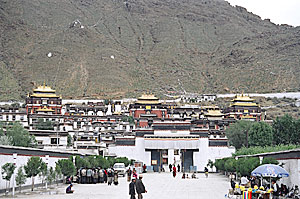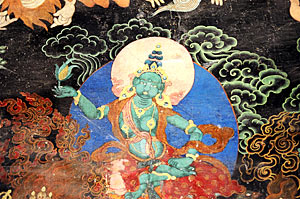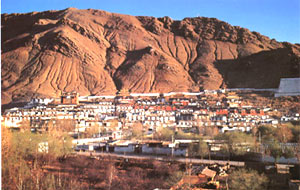Drepung Monastery
 Drepung is the largest Drepungmonastery in Tibet. It houses 10,000 monks of the Gelugpa order. It was founded in 1416 by a displine of Tsong Khapa under the patron of a noble family and enlarged by the fifth Dalai lama. it lies 10 kms to the west of Lhasa and is built on the Mount Guopei. Drepung monastery is of great historical importance not only in that it produced some of Tibet's most renowned spiritual leaders, but alos in that it always enjoyed significant political influence. It covers a floor space of more than 200 thousand square meters. At its peaks, it had a registration of more than 10,000 monks. Many lamas had learned there. In 1994 , there were about 200 monks in residence. a significant number of the buildings were only empty shells remaining from what was apparently deliberate destruction.
Drepung is the largest Drepungmonastery in Tibet. It houses 10,000 monks of the Gelugpa order. It was founded in 1416 by a displine of Tsong Khapa under the patron of a noble family and enlarged by the fifth Dalai lama. it lies 10 kms to the west of Lhasa and is built on the Mount Guopei. Drepung monastery is of great historical importance not only in that it produced some of Tibet's most renowned spiritual leaders, but alos in that it always enjoyed significant political influence. It covers a floor space of more than 200 thousand square meters. At its peaks, it had a registration of more than 10,000 monks. Many lamas had learned there. In 1994 , there were about 200 monks in residence. a significant number of the buildings were only empty shells remaining from what was apparently deliberate destruction.
Sera Monastery
One of the largest monasteries of Gelugpa, sits at the foot of Hill Tetipu. It was built by one of disciples of Zonggaba in 1419.Sera means Wild Rose Gaden since opulent wild rose woods once grew around it. Song Khapa started to built the monastery to enshrine hynagriva. The center of the Sera is the main Assembely Hall, in tibet which is the grandest hall of Sera. It ocupies a floor space of 1,000 square meters the four stories hall has four chapels in which Arhats, Manjushri, tsong Khapa and chenrezi are enshrined respectively. It has three colleges.Sera je college was first founded in 1435 and expanded by a Mongol King in 17th century. the building has five streys, covering a space of a thousand square meters. In its main hall 11 stupas of Ganden tripas and Ratreng tripas were contained. On 27th of the 12th month of the Tibetan calendar, the monastery holds the grand Sera Bungchen Festival, which attracts flocks of Buddhists and others. Sera keeps a collection of murals in perfect, original condition. Its statues of Maitreya, Bodhisattvas, and Arhats are very noteworthy. Scriptures written in gold powder, scroll paintings, tapestry portrait of Jamchen Chojey, thangkas are characteristics of Sera.
Nechung Monastery
Nechung Monastery has an important place in Tibetan history as the seat of Nechung, the state Oracle of Tibet. Its located just below Drepung Monastery, four miles west of Lhasa. The monastery has about 5 monks.
Gyantse Monastery
Gyantse is a small town south west of Lhasa. It is one of the monastery where the chinese have not changed much. It is known because of its fortress, the Dzong, a very special building, the kimbum, and a monastery, the pelkor Chode. the reason why people build a town there is because of the trade in wool. It was on the road to India. Nowadays it is close to the friendship highway. this is road that literally makes its name true it is a sandy road that turns out to be jammed because of erosion. The Dzong Fort is build on a hill.
there are number of monasteries inside the walls but today there is just one left. It is visited by Gelugpa monks.
Shalu Monastery
Shalu Monastery was founded by Chetsun Sherab Jungary in the region of Nyangro. In the early 14th century it became the most important center of learning under Button Rinpoche. This monastery is quite different from Tibet's other monasteries as it had the Sam style of slanting ridged roofs with guttering at the eaves as the monasteries of inland China. this monastery is built in Tibetan style after all out of irregular stone slab. Judjing from its exterior appearance , Shalu was a singular mixture of the Han and Tibetan Style. Shalu monastery is small in size but it has a long history. The monastery which dates back to the 11th century, rose to prominence in the 14th century, when its abbot, Buton Rinchen Drup, emerged as foremost interpreter of Sanskrit Buddhist texts of his day. Shalu was also a centre for training in skills such as trance walking, made famous by the flying monks.
Ganden Monastery
Ganden Monastery was established in around 1409 by the great master Tsongkhapa. Ganden means is the Tibetan name for the paradise of the Buddha of the future. It was for many centuries one of the main centers of the Gelugpa sect, until it was developed almost completely by Chinese forces in 1959. The three main sights of Ganden Monastery per se are the Serdung, which contains the Golden Tomb of Tsongkhapa, the Tsokchen Assembly Hall and the Ngam Cho Khang Chapel where Tsongkhapa traditionally taught his students.
The Ganden Lingkhor
A visit to Ganden Monastery is incomplete without walking its our long pilgrimage route. This walk will also introduce many aspects of a Tibetan pilgrimage route. Our path is signposted by a rich array of colorful prayer flags fluttering in the breeze. Either side, rock faces are rubbed with yak butter offerings and small shrines in rock fissures are filled with tsha-tshas, small religious offering tablets made of clay deposited by pilgrims
Zezhol Monastery :
The monastery is different with other monasteries since it is an important religious center of Tibet. The monastery lies at the foot of Zezhol Hill, 37 kms from Tingchen country. Monastery was rebuilt in the middle of the 14th century. History of the monastery can be tracked back to as far as 3,000 years ago. In Tibet the name of the monastery means Six Peaks due to its topography around. Zezhol is one of the few largest Bon Monasteries existing in Tibet, which still keeps many followers and most complete Bon religious rituals. The monastery still keeps a weird Bon religious tradition - naked group dancing.
Samyae Monastery :
Samye was Tibet's very first monastery and has a history that spans over 1,200 years. It is designed to represent the Buddhist universe and many of the buildings in the courtyard are cosmological symbols. The central building of Samye, its foremost feature, comprises a synthesis of architectural styles: the ground and first floors were originally Tibetan in style, the second floor was Chinese and the third floor Indian.
Trandruk Monastery :
 Trandruk Monastery, ShannanTrandruk Monastery is one of the earliest Buddhist monasteries in Tibet, a significant stop for Tibetan pilgrims. Dating back to the 7th century reign of Songtsen Gampo, it is one of the "Demoness Subduing" temples of Tibet. Trandruk Monastery is also famous for its " Pearl Tangka" which is the image of Compassion Buddha made up of almost 30,000 pearls, and many other jewelries.
Trandruk Monastery, ShannanTrandruk Monastery is one of the earliest Buddhist monasteries in Tibet, a significant stop for Tibetan pilgrims. Dating back to the 7th century reign of Songtsen Gampo, it is one of the "Demoness Subduing" temples of Tibet. Trandruk Monastery is also famous for its " Pearl Tangka" which is the image of Compassion Buddha made up of almost 30,000 pearls, and many other jewelries.
Dratang Monastery :
Dratang Monastery was established in 1081, the founder of monastery Drapa Eshepa who is one of the 13 sages in Dranuang Country. This monastery belongs to Sakyapa Sect. The monastery absorbed some architectures style from Someye Monastery, there were three surroundings walls but now only 750 meters left, it has 3 stories before but now only one left. The murals of this monastery are the most precious.
Minzohling Monastery :
Minzohling monastery was built in the 10th century and had its current name when it was rebuilt in 1677. It is one of the three great monasteries of the Rnyingma Sect. The monastery has paid attention to the research of Buddhist classics, astronomical calendar, calligraphy rhetoric and Tibetan medicines and is famous for its achievements in these fields.
Changzhug Monastery :
Changzhug Monastery was built in the 17th century and has been repaired in various historical periods. Monastery standing by the highway on the east bank of the Yalong River in Nedong country. The monastery houses a precious Thangka picture of a Buddha inlaid with pearls and gems.
Tashilhungpo Monastery :
 Tashilhungpo MonasteryTashilhungpo Monastery located in southern slope of the Nyima Mountain to the west of the Xiage City. Monastery was built in 1447.The monastery was built under the supervision of the first Dalai Lama Zhuba, a discipline of Zongkapa, the founder of Yellow Sect. The complex is built symmetrical against the Nyima Mountain its wall, over 3,000 meters long and built according to the topography of the mountain, surrounds 57 buildings, or more than 3,600 rooms.
Tashilhungpo MonasteryTashilhungpo Monastery located in southern slope of the Nyima Mountain to the west of the Xiage City. Monastery was built in 1447.The monastery was built under the supervision of the first Dalai Lama Zhuba, a discipline of Zongkapa, the founder of Yellow Sect. The complex is built symmetrical against the Nyima Mountain its wall, over 3,000 meters long and built according to the topography of the mountain, surrounds 57 buildings, or more than 3,600 rooms.
Xalhu Monastery :
Xalhu monastery is famous for its four treasures. the first is the printing plate of Buddhist scriptures, which is made of 108 blocks of wood by Abbot Purdain. The second treasures is the holy jar made of bronje. It is claimed that inside the jar is the clearest water in the world, which is replaced every 12 years. The mouth of the jar is covered with red cloth. Legend says that the water can cure diseases and wash away dirt and filth. The third is the stone tablet with six characters. The fourth is the huge basin-shaped stone in which the living Buddha Jigzun Xerab Qoinnyai, who built the monastery of Sagya.
Sakya Monastery :
The southern monastery is composed of southern and northern Monasteries. The northern monastery was built in 1097 and was damaged. Now while Southern Monastery was rebuilt in 1268. It houses a great amounts of cultural relics including the titles, seals, crowns, garments and ornaments awarded by the Yuan imperial court to the local officials, the statues of Buddhas,rituals instruments and porcelains from the song, Yuan and other later dynasties, and the precious murals of historical themes. It preserve great numbers of books such as the "Bakgyur","Bstanggyur", and other Tibetan classics on astronomy, history, medicines and literature.
Open hours: 9:00- 12:00 and 15:00-16:00